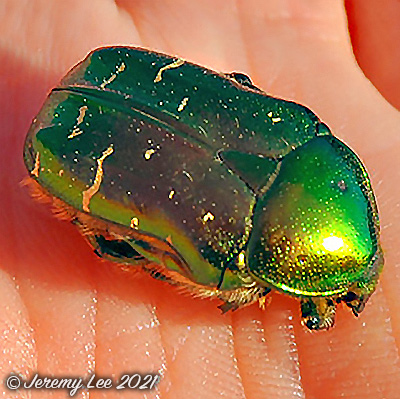
 |
|
Scientific Classifications explained » Amphibians » Ants » Aphids » Bees » Beetles » Birds » Bugs » Butterflies » Caterpillars » Damselflies » Dragonflies » Earwigs » Flies » Frog/Leafhoppers » Fungi » Galls » Grasshoppers » Harvestmen » Hoverflies » Lacewings » Ladybirds » Leaf Mines » Lichens » Mammals » Millipedes » Mosses » Moths » Sawflies » Slugs » Snails » Spiders » Trees & Shrubs » Wasps » Wild Flowers » Woodlice » Postboxes |
UK Nature > Beetles > Cetonia aurata

Scientific Name: Cetonia aurata Common Name: Rose Chafer Cetonia aurata, more commonly known as the Rose chafer, is a large, broad beetle that is found in grassland, scrub and along woodland edges. The adults feed on flowers, particularly Dog Roses, during the summer and autumn, and can be spotted in warm, sunny weather. The larvae feed on decaying leaves, plants and roots, living in the soil for several years as they develop. When they pupate, they hibernate in the soil or in rotting wood over winter, ready to emerge as adults the following spring. The Rose chafer is metallic coppery-green with small, creamy-white streaks on its wing cases. It might be mistaken for the Noble Chafer, but this is a much rarer beetle associated with traditional orchards. The Rose chafer is often seen on flowers in the garden, and is sometimes considered a pest for munching its way through these plants. However, it is an important detritivore - feeding on dead and decaying matter and recycling its nutrients - and is a helpful addition to any compost heap. Widespread in the UK, but scarce in England and Wales. |
|

https://www.uknature.co.uk is a website dedicated to showing the immense diversity of UK nature and wildlife. Our vast range of habitats, from lowland arable to snow covered mountains, from storm-ravaged coastlines to peaceful inland freshwater lakes and rivers, from dry, sandy heaths to deciduous and coniferous forests, all these habitats contribute to the abundance of UK nature. We have wild birds in huge numbers either residing or visiting our shores (597 recorded species as at July 2013) and we must also not forget the humble back garden with its grass lawns, flower beds filled with nectar rich flowers, shrubs and trees, all designed to attract huge numbers of insects such as bees, moths, butterflies and hoverflies; and finally the small ponds which provide safe havens for frogs, toads, newts and even slow worms and grass snakes. www.uknature.co.uk is the showcase for my personal passion, photographing uknature in all its glory. I sincerely hope you all enjoy the fruits of my labours. This site and all images contained therein is © Jeremy Lee 2004 - 2025. All Rights Reserved. Site design by Jeremy Lee. Site development & IT Support by Stuart Lee. |